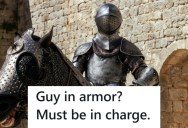Glimpse into Iran with Lonely Planet Photog Amos Chapple
by twistedsifter
Kiwi photographer Amos Chapple began his career as a press photographer for the New Zealand Herald. Three years later he joined the Our Place project, an initiative that took him around the world, on assignment to photograph all of the world’s UNESCO world heritage sites from 2006-1010 (possibly the coolest assignment ever).
Chapple, who has traveled to 59 countries, was named an ‘Editor’s Choice’ in the 2012 National Geographic Photo Contest and winner of the 2009 Cathay Pacific Traveler of the Year award. Now a full-time independent freelancer, Chapple is available for editorial commissions (contact him here).
This past weekend, Chapple uploaded a fascinating gallery of images to Reddit from his three trips to Iran. The post was well-received, reaching the top spot on the front page.
The entire 20-picture gallery can be seen on Imgur, complete with descriptions and links to more information. All photos were shot with a Lumix GH2 + various lenses. Chapple is passionate about Iran and its people. He says they are the friendliest he has ever encountered. Through his photography, Chapple wants the rest of the world to understand that there is a notable difference in mindset between those in power and the average citizen.
For more, visit Amos Chapple’s official website [amoschapple.com] and be sure to check out the entire album on Imgur.
[via Reddit]
1.

Palangan Village, in the mountains near the Iraq border: Palangan, illustrative of many of the country’s rural settlements, has benefited handsomely from government support. Many villagers are employed in a nearby fish farm, or are paid members of the Basij, whose remit includes prevention of ‘westoxification’, and the preservation of everything the 1979 Islamic revolution and its leader the Ayatollah Khomeini stood for, including strict rules on female clothing and male/female interaction. [Source]
2.

A shepherd leads his flock out to pasture in the mountains on the Iran/Iraq border. [Source]
3.

Two shepherds lead Palangan’s flock of communally owned sheep out to pasture. The government’s spending in some rural regions has bought them a network of loyal followers who can be scrambled at any time to crush trouble in the urban centres. Rural Basij were used as a part of the crackdown in 2009 which resulted in the deaths of seven anti-government protestors [Source]. For more info: BBC – Basij militia force
4.

A worker inside Vakil Mosque, Shiraz. The mosque now serves as a tourist attraction but sees only a trickle of visitors. Although tourism is on the increase, Western tourists still make up only 10% of the total. One tourist guide said westerners are scared away by the bloodcurdling rhetoric of a government which is completely out of touch with ordinary Iranians [Source]. For more info: Wikipedia – Tourism in Iran
5.

Azadi (“Freedom”) Tower, the gateway to Tehran designed in 1966 by a then 24 year-old Hossein Amanat. As a practicing Bahai’i, Hossein was forced to flee Iran after the Islamist government labeled followers of the religion “unprotected infidels”. He now lives in Canada. [Source]
6.

Detail of Persepolis. After the Islamic Revolution, hardline clerics called for the destruction of the site, but official unease prevailed. “They realized this would unite the people against them” says an English teacher named Ali, quoted in National Geographic. [Source]
7.

View of central Tehran from inside a minaret in Sepahsalar Mosque. [Source]
8.

At the Sa’adabad Palace complex in northern Tehran, Islamic revolutionaries sawed a statue of the deposed Shah in half. Today schoolchildren are taken on group visits past the boots and into the palace to see the decadence of the former Shah’s living quarters. [Source]
9.

In Tehran, a collection of modern art valued at $2.5 billion is held by the Museum of Contemporary Art. In a little-publicized exhibition in 2011, the works, including pieces by Warhol (pictured), Pollock, Munch, Hockney and Rothko were put on display for the first time since 1979 when the owner of the art, Queen Farah Pahlavi was forced to flee Iran with her husband, the late Shah of Iran [Source]. For more info: The Guardian – Tehran exhibition reveals city’s hidden Warhol and Hockney treasures
10.

A Kurdish man settles in for a night of guarding some roadworking machinery in the mountains near the Iran/Iraq border. The border is rife with smugglers who carry alcohol from Iraq (where alcohol is legal) into the villages on the Iranian side. From there it is transported by vehicle to the cities. In Tehran a can of beer on the black market fetches around $10 USD [Source]. For more info: Time – Smuggling Between Iran and Iraq
11.

Women in the hills above Tehran at dusk. Concealing clothing in the Islamic Republic, including head coverings, is mandatory for women, but the exact definition of “modest” is flexible, leading to a tug of war between young females and the authorities each spring. Outside metro stations female police can be seen regularly checking the passers-by. If a woman’s dress is considered “immodest” she is arrested and taken into custody. In 2010 a senior cleric in Tehran blamed the frequency of earthquakes in Iran on women who “lead young men astray” with their revealing clothing [Source]. For more info: BBC – Iranian cleric blames quakes on promiscuous women
12.

Two young twins on the Tehran Metro. [Source]
If you enjoyed this post, the Sifter
highly recommends:
Categories: BEST OF, STORIES, TRAVEL
Tags: · iran, photo series

Sign up to get our BEST stories of the week straight to your inbox.




